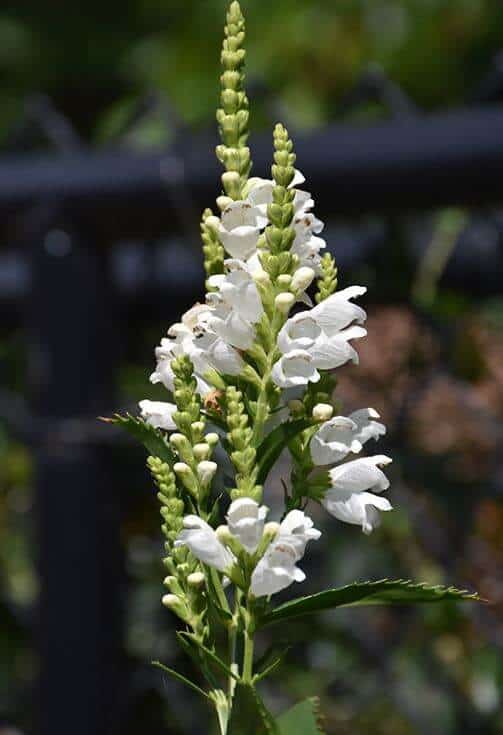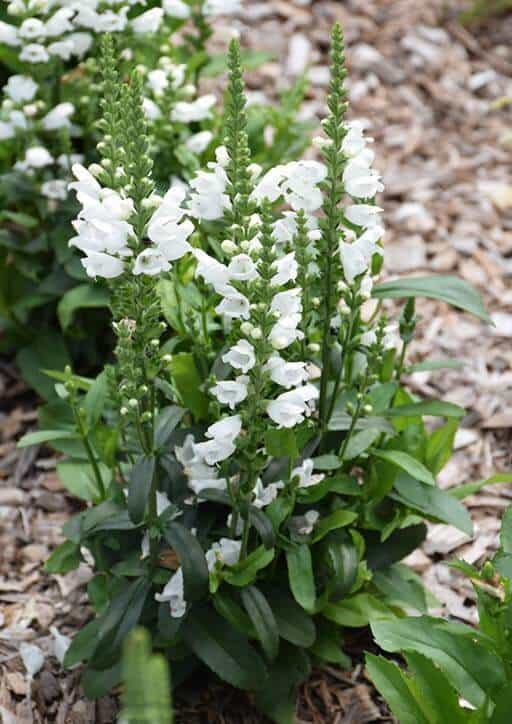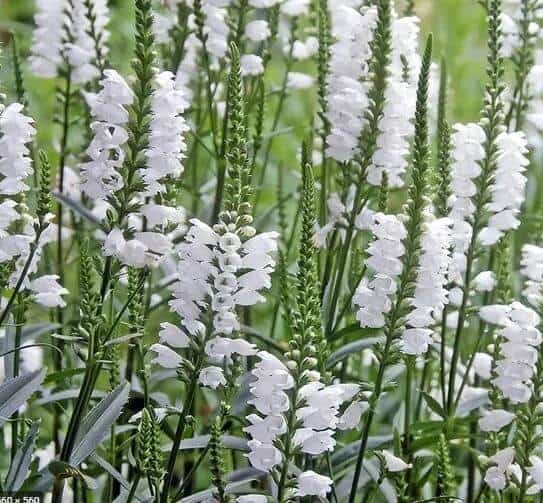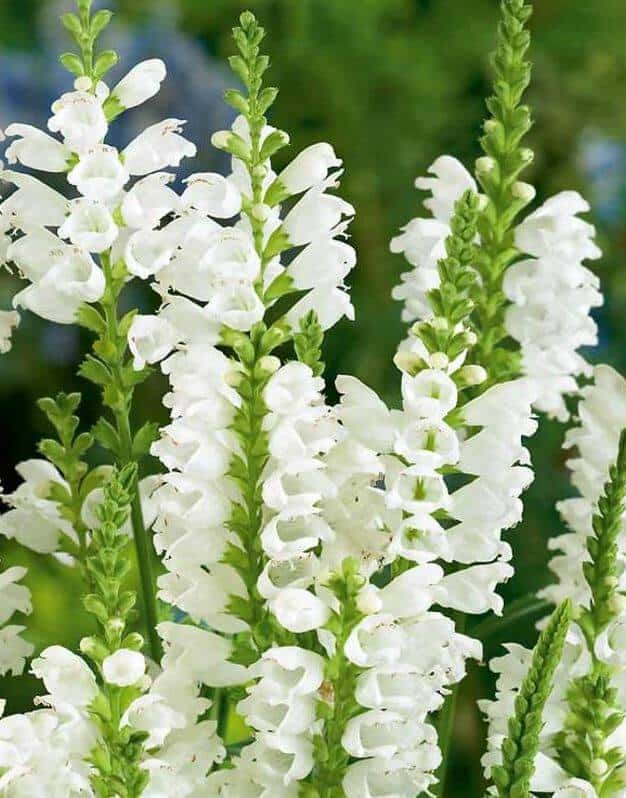Last Updated on January 5, 2023 by a Friendly Gardener
This herbaceous rhizomatous perennial plant boasts an unusual name, after all, who ever thought of describing a plant as “obedient”? And yet, the Physostegia virginiana or the ‘Crystal Peak White’cultivar, both members of the Lamiaceae or mint family, are called obedient plants because even when twisted, the plant’s lovely white flowers remain in place. In fact, if you move a flower in a new direction, it will remain temporarily in the new angle as if attached by a hinge.
The White Obedient Plant is also known as the “False Dragonhead” because its blooms remind us of the Dragonhead blooms of the Dracocephalum. Generally, free-growing obedient plants will produce blooms that are lavender to pink and can grow as high as 4 feet.
Native to the North American continent, you’ll find it as far north as Quebec or Manitoba, and as far south as Florida or as far west as New Mexico. It can be found in prairies, meadows, or on the banks of streams among other spots.
The White Obedient plant is a bushy plant that tends to spread. It produces numerous hooded, tubular-shaped, lipped blooms that grow completely around spikes growing in an upward direction above the dark green, lance-shaped foliage.
Blossoms appear beginning in July and continue through September and are rich in both pollen and nectar. They are a favorite of bees, hummingbirds, and butterflies, and they look spectacular when positioned in groups. Obedient plant white flowers also lend themselves to cutting and they are resistant to local wildlife like rabbits and deer. Blooms will turn brown eventually and produce seeds.
The ideal time for planting is during the months of May and June. If you are sowing seeds, do so in September, October, or November so that the plants are ready for the following season.
Plants will grow to an average of 14 inches in height while flower heights and spreads can reach 24 inches. Plants should be spaced approximately 20 inches apart if you are mass planting. They have a medium growth rate.
With proper maintenance, they can live and regenerate for approximately 10 years. When winter arrives, these plants will die back to the crown. Come spring, plants regrow from the base.
White Obedient Plant Care

Perfect for general use in garden landscaping and mass planting, this particular species does need some maintenance occasionally. They should be trimmed and ready at the beginning of spring when active seasonal growth resumes. Taller exemplars may need support or to be staked. The White Obedient plant can be container cultivated as an annual.
It is a spreading plant, either through self-seeding or rhizomes, so gardeners beware! In some environmental conditions, it can even out-compete other invasive species for garden space.
Soil

This is a hardy garden plant that can thrive in an ample variety of soil types including clay, sandy, heavy, or rocky soil as long as it is well-draining. It does not require a specific soil pH but does best in acidic, moist soils. The plant stems can flop if the soil is overly rich or fertilized. Moist clay soils will feed the plant’s aggressive tendencies.
One good thing about the Crystal Peak White Obedient cultivar is that its shorter stems do not flop and that the flowers will not brown as they age.
Light
The White Obedient Plant does best when placed in full sun with a minimum of six full hours daily. They can manage in partial shade if there are 4 to 6 hours of sunlight. If there is too much shade, plant stalks may flop over.
Water
The White Obedient plant will thrive in medium to moist soil conditions. It can survive an occasional drought, but you may see some lower foliage turn yellow and drop. This plant does not do well in drier environmental conditions. Keep soil beds evenly moistened.
Temperature
Our White Obedient Plant does well in average gardening conditions. It thrives in the country as well as in the middle of the city even with pollution. It can be cultivated in USDA hardiness zones 3 through 9.
Feeding
Fertilization is not necessary. It’s sufficient to replicate the growing conditions that this plant likes.
Pruning
More than pruning you may want to know how to contain these plants. You may want to look for a cultivar that does not spread through rhizomes. Or you can plant alongside other aggressive spreaders, so they compete to contain each other. Other methods include loosening the soil bed and removing plants you don’t want or planting your obedient plant in pots that you have lined with a weed barrier.
White Obedient Plant Propagation

White Obedient plants can be propagated using seeds or rhizome cuttings. To propagate using seeds:
- These plants need 60 days of cold stratification, so either plant them shallowly in winter or place them in the refrigerator before you sow.
- Press Obedient plant seeds into the soil or in moist potting soil and cover them lightly. Your container should be in a spot with morning sun and afternoon shade when the temperatures warm a bit.
- Mist seeds in the mornings.
- Expect seed germination in a few weeks. For garden-sown seeds, expect germination as temps increase.
Harvesting Your Own Seed
You can easily propagate using seeds you harvest. Approximately 2 months after blooms appear, they will be substituted by small brownish seed pods. Trim these from stalks and set them aside in a paper bag in a dry, cool place. After shake the bag gently release the seeds from the pods. You can keep your harvested seeds in an envelope for as long as 2 years if stored in a dry, cool location.
To propagate using rhizome cuttings:
- Go to mature Obedient plants.
- Look for a new, small plant.
- Dig up a couple of inches of rhizome root on either side of the plant and trim the rhizome.
- Transfer it to a container with potting soil for several days and place in the shade.
- Now move your container to a spot with morning shade and afternoon sun for approximately a week to 10 days.
- Transplant your new plant into your preferred garden spot.
White Obedient Plant Problems

Aphids and spider mites are attracted to the White Obedient plant and rust can be a problem. Treat rust with fungicides like organic Neem oil.
If leaves develop brown edges this may be due to underwatering.
White Obedient species can be very invasive and aggressive as spreaders. The Crystal Peak White Obedient cultivar is supposedly a bit less aggressive in terms of spreading.
White Obedient Plant Toxicity

There are no toxic or poisonous effects reported for cats, dogs, birds, horses, humans, or livestock. It is not among the toxic plants listed by the ASPCA.

